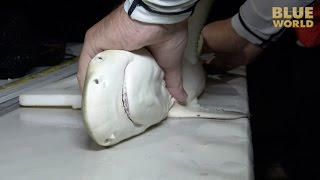This time on Jonathan Bird's Blue World, Jonathan travels to the Turks and Caicos to learn how marine biologists conduct underwater research!
在这一集的乔纳森《蓝色世界》中,乔纳森将前往特克斯和凯科斯群岛学习海洋生物学家如何进行水下研究!
Hi, I'm Jonathan Bird and welcome to my world!
嗨,我是乔纳森·伯德,欢迎来到我的世界!
It's the middle of the night on the tropical island of South Caicos.
现在是热带岛屿南凯科斯岛的午夜时分。
A group of marine biology students are wading into a mangrove, helping to tag baby sharks.
一群海洋生物学专业的学生正涉水进入红树林,帮助给小鲨鱼贴上标签。
How I got here is an interesting story.
我怎么会来到这里是一个有趣的故事。
I get a lot of emails asking about how to become a marine biologist.
我收到很多电子邮件,询问如何成为一名海洋生物学家。
You might be surprised to discover that I'm not a marine biologist!
你可能会惊讶地发现,我并不是海洋生物学家!
So I think it would be fun to check out some of the ways that marine biology students learn what it takes to do field work.
所以,我想研究一下海洋生物学学生学习进行野外作业的一些方法会很有趣。
I'm off to the sunny but remote island of South Caicos, in the Turks and Caicos Islands, just southeast of the Bahamas.
我要去阳光明媚但偏僻的南凯科斯群岛,它位于特克斯和凯科斯群岛那里,就在巴哈马东南部。
Here, the School for Field Studies operates a field research facility where college students from all over the United States come for some hands-on marine biology field work.
在这里,野外研究学院运营着一个野外研究机构,来自美国各地的大学生在这里进行一些实际的海洋生物野外工作。
Faculty at the School for Field Studies have ongoing research projects investigating fisheries management, reef health, shark populations and even human impact.
野外研究学院的教师们正在进行调查渔业管理、珊瑚礁健康、鲨鱼种群,甚至是人类影响等研究项目。
My goal?
我的目标?
To spend some time tagging along with the students to see what they do every day in their pursuit of a degree in marine biology.
花点时间和学生们在一起,看看他们在攻读海洋生物学学位的过程中每天都做些什么。
My day begins with the shark research team led by Professor Aaron Henderson.
我的这一天从亚伦·亨德森教授领导的鲨鱼研究小组开始。
Henderson and his students are investigating how the marine protected areas around South Caicos are affecting the shark population.
亨德森和他的学生正在调查,南凯科斯群岛周围的海洋保护区对鲨鱼种群的影响。
Their first task for the day is to deploy some baited camera rigs.
他们今天的首要任务是部署一些诱饵摄像机。
These rigs will hopefully attract and film several species of sharks.
希望这些设备能够吸引,并拍摄到几种鲨鱼。

The goal: to learn how many and what species of sharks are here in the marine protected area.
目的是了解海洋保护区内有多少种鲨鱼,以及种类。
Many different species visit the cameras including Nurse sharks, Caribbean Reef sharks, Tiger sharks, Lemon sharks and even Great Hammerheads!
许多不同种类的鲨鱼都会在镜头前出现,包括护士鲨、加勒比海礁鲨、虎鲨、柠檬鲨,甚至还有大锤头鲨!
Next the team deploys what are known as "drum lines."
接下来,团队将部署所谓的“滚筒线。”
These are baited hooks attached to a float and a weight.
这些是挂在浮子和重物上的饵钩。
They are designed so that sharks can swim around when they are caught, so they won't drown.
它们的设计使鲨鱼在被捕获时能游来游去,这样它们就不会淹死。
The goal is to catch sharks so they can be tagged and released.
我们的目标是捕到鲨鱼,然后给它们做标记,再放生。
With five drum lines set, the team goes back to the first one and checks for a shark.
在设置了五个滚筒线之后,团队返回到第一个滚筒线那里,查看是否有鲨鱼。
The goal is to check each line at least every 10-15 minutes, so a shark doesn't stay hooked too long.
目标是至少每10-15分钟检查一次鱼线,这样鲨鱼就不会被勾住太久。
It doesn't take long before they have their first shark.
不久他们就捕获了第一条鲨鱼。
Dr. Henderson places a tag on its dorsal fin, while the students take a small tissue sample from is tail for an isotope analysis of the shark's diet.
亨德森博士在它的背鳍上贴上标签,学生们则从它的尾部取一小块组织样本,进行有关鲨鱼饮食的同位素分析。
While the shark team is out tagging sharks, another team of students is heading out to sea as well.
当鲨鱼小队出动去标记鲨鱼时,另一队学生也出海了。
This group is studying the fish population of the island, again trying to determine the effectiveness of marine protected areas.
这个小组正在调研该岛的鱼类种群,再次试图确定海洋保护区的有效性。
Instead of working from the boat, these students will be doing their research with scuba gear.
这些学生不用在船上工作,而是采用潜水设备进行研究。
Underwater, the team heads to a nice section of coral reef and begins a transect.
研究小组在水下前往一个美丽的珊瑚礁区域,并开始采集样带。
Essentially they reel out a very long tape measure over the reef, which defines a specific path of a specific length.
基本上,他们在礁石上抽出很长的一个带条,它能确定一个特定长度的专有路径。
Of course swimming over the reef causes all the fish to swim away and hide.
当然,游过礁石会让所有的鱼游走并躲起来。
So they wait a few minutes for the fish to go back to their normal routine, then they slowly swim along the transect taking notes on what species of fish they see and keeping count.
所以他们等了几分钟,让鱼恢复到正常的生活方式中,然后慢慢地沿着样带游动,记录下他们看到的鱼的种类,并且记录数量。











